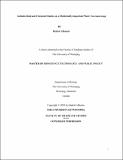Antimicrobial and Chemical Studies on a Medicinally important Plant: Curcuma longa
Metadata
Show full item recordAuthor
Alhazmi, Hadeel
Date
2021-04-20Citation
Alhazmi, Hadeel. Antimicrobial and Chemical Studies on a Medicinally important Plant: Curcuma longa; A thesis submitted to the Faculty of Graduate Studies of The University of Winnipeg [in partial fulfillment of the requirement of the degree] Master of Bioscience, Technology, and Public Policy, Department of Biology. Winnipeg, Manitoba, Canada: University of Winnipeg, 2021. DOI: 10.36939/ir.202104261444.
Abstract
This thesis describes phytochemical studies on the methanolic extract of Curcuma longa; a medicinally important plant used as indigenous medicine for the treatment of wounds in South Asian and African countries. The crude extract displayed antibacterial activity against the Gram-positive bacterium, Staphylococcus aureus, but was inactive against Gram-positive bacterium Streptococcus agalactiae. This extract also did not show antibacterial activity against Gram-negative bacteria, Escherichia coli and Pseudomonas aeruginosa. Based on the observed antibacterial activity, it was decided to carry out phytochemical investigation of crude methanolic extract of C. longa to isolate and characterize natural products and evaluate them for antimicrobial activity. These efforts resulted in the identification of three known natural products: curcumin (39) sclareolide (40) and atalantoflavone (41). Structures of these compounds were established with the aid of NMR spectroscopic studies. Compounds (40) and (41) have been isolated for the first time from this plant. Compounds (39-41) were found to be inactive against the Gram-positive bacterium, Staphylococcus aureus, and Gram-negative bacterium, Escherichia coli.

